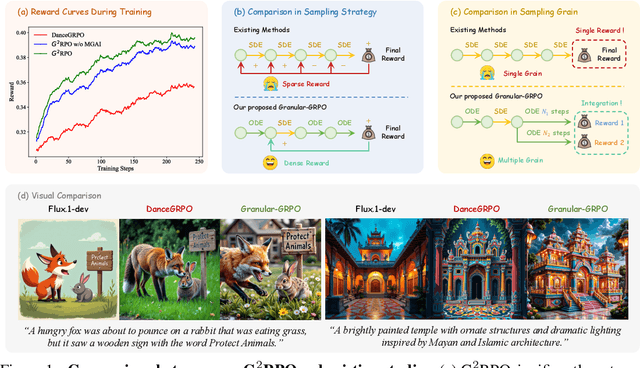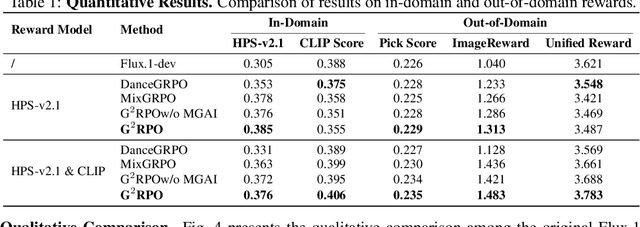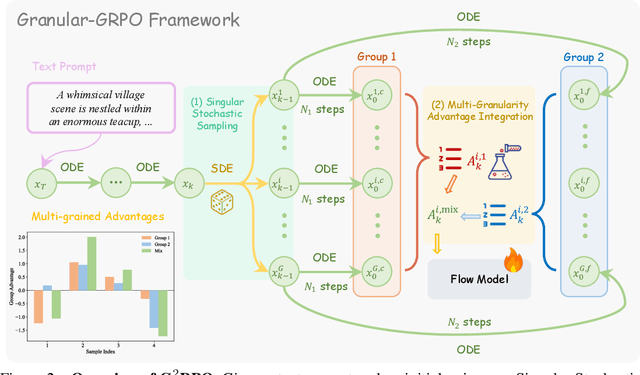Yuhang Zang
Spatial-SSRL: Enhancing Spatial Understanding via Self-Supervised Reinforcement Learning
Oct 31, 2025Abstract:Spatial understanding remains a weakness of Large Vision-Language Models (LVLMs). Existing supervised fine-tuning (SFT) and recent reinforcement learning with verifiable rewards (RLVR) pipelines depend on costly supervision, specialized tools, or constrained environments that limit scale. We introduce Spatial-SSRL, a self-supervised RL paradigm that derives verifiable signals directly from ordinary RGB or RGB-D images. Spatial-SSRL automatically formulates five pretext tasks that capture 2D and 3D spatial structure: shuffled patch reordering, flipped patch recognition, cropped patch inpainting, regional depth ordering, and relative 3D position prediction. These tasks provide ground-truth answers that are easy to verify and require no human or LVLM annotation. Training on our tasks substantially improves spatial reasoning while preserving general visual capabilities. On seven spatial understanding benchmarks in both image and video settings, Spatial-SSRL delivers average accuracy gains of 4.63% (3B) and 3.89% (7B) over the Qwen2.5-VL baselines. Our results show that simple, intrinsic supervision enables RLVR at scale and provides a practical route to stronger spatial intelligence in LVLMs.
$\text{G}^2$RPO: Granular GRPO for Precise Reward in Flow Models
Oct 02, 2025



Abstract:The integration of online reinforcement learning (RL) into diffusion and flow models has recently emerged as a promising approach for aligning generative models with human preferences. Stochastic sampling via Stochastic Differential Equations (SDE) is employed during the denoising process to generate diverse denoising directions for RL exploration. While existing methods effectively explore potential high-value samples, they suffer from sub-optimal preference alignment due to sparse and narrow reward signals. To address these challenges, we propose a novel Granular-GRPO ($\text{G}^2$RPO ) framework that achieves precise and comprehensive reward assessments of sampling directions in reinforcement learning of flow models. Specifically, a Singular Stochastic Sampling strategy is introduced to support step-wise stochastic exploration while enforcing a high correlation between the reward and the injected noise, thereby facilitating a faithful reward for each SDE perturbation. Concurrently, to eliminate the bias inherent in fixed-granularity denoising, we introduce a Multi-Granularity Advantage Integration module that aggregates advantages computed at multiple diffusion scales, producing a more comprehensive and robust evaluation of the sampling directions. Experiments conducted on various reward models, including both in-domain and out-of-domain evaluations, demonstrate that our $\text{G}^2$RPO significantly outperforms existing flow-based GRPO baselines,highlighting its effectiveness and robustness.
MinerU2.5: A Decoupled Vision-Language Model for Efficient High-Resolution Document Parsing
Sep 26, 2025Abstract:We introduce MinerU2.5, a 1.2B-parameter document parsing vision-language model that achieves state-of-the-art recognition accuracy while maintaining exceptional computational efficiency. Our approach employs a coarse-to-fine, two-stage parsing strategy that decouples global layout analysis from local content recognition. In the first stage, the model performs efficient layout analysis on downsampled images to identify structural elements, circumventing the computational overhead of processing high-resolution inputs. In the second stage, guided by the global layout, it performs targeted content recognition on native-resolution crops extracted from the original image, preserving fine-grained details in dense text, complex formulas, and tables. To support this strategy, we developed a comprehensive data engine that generates diverse, large-scale training corpora for both pretraining and fine-tuning. Ultimately, MinerU2.5 demonstrates strong document parsing ability, achieving state-of-the-art performance on multiple benchmarks, surpassing both general-purpose and domain-specific models across various recognition tasks, while maintaining significantly lower computational overhead.
CapRL: Stimulating Dense Image Caption Capabilities via Reinforcement Learning
Sep 26, 2025Abstract:Image captioning is a fundamental task that bridges the visual and linguistic domains, playing a critical role in pre-training Large Vision-Language Models (LVLMs). Current state-of-the-art captioning models are typically trained with Supervised Fine-Tuning (SFT), a paradigm that relies on expensive, non-scalable data annotated by humans or proprietary models. This approach often leads to models that memorize specific ground-truth answers, limiting their generality and ability to generate diverse, creative descriptions. To overcome the limitation of SFT, we propose applying the Reinforcement Learning with Verifiable Rewards (RLVR) paradigm to the open-ended task of image captioning. A primary challenge, however, is designing an objective reward function for the inherently subjective nature of what constitutes a "good" caption. We introduce Captioning Reinforcement Learning (CapRL), a novel training framework that redefines caption quality through its utility: a high-quality caption should enable a non-visual language model to accurately answer questions about the corresponding image. CapRL employs a decoupled two-stage pipeline where an LVLM generates a caption, and the objective reward is derived from the accuracy of a separate, vision-free LLM answering Multiple-Choice Questions based solely on that caption. As the first study to apply RLVR to the subjective image captioning task, we demonstrate that CapRL significantly enhances multiple settings. Pretraining on the CapRL-5M caption dataset annotated by CapRL-3B results in substantial gains across 12 benchmarks. Moreover, within the Prism Framework for caption quality evaluation, CapRL achieves performance comparable to Qwen2.5-VL-72B, while exceeding the baseline by an average margin of 8.4%. Code is available here: https://github.com/InternLM/CapRL.
SPARK: Synergistic Policy And Reward Co-Evolving Framework
Sep 26, 2025



Abstract:Recent Large Language Models (LLMs) and Large Vision-Language Models (LVLMs) increasingly use Reinforcement Learning (RL) for post-pretraining, such as RL with Verifiable Rewards (RLVR) for objective tasks and RL from Human Feedback (RLHF) for subjective tasks. However, RLHF incurs high costs and potential reward-policy mismatch due to reliance on human preferences, while RLVR still wastes supervision by discarding rollouts and correctness signals after each update. To address these challenges, we introduce the Synergistic Policy And Reward Co-Evolving Framework (SPARK), an efficient, on-policy, and stable method that builds on RLVR. Instead of discarding rollouts and correctness data, SPARK recycles this valuable information to simultaneously train the model itself as a generative reward model. This auxiliary training uses a mix of objectives, such as pointwise reward score, pairwise comparison, and evaluation conditioned on further-reflection responses, to teach the model to evaluate and improve its own responses. Our process eliminates the need for a separate reward model and costly human preference data. SPARK creates a positive co-evolving feedback loop: improved reward accuracy yields better policy gradients, which in turn produce higher-quality rollouts that further refine the reward model. Our unified framework supports test-time scaling via self-reflection without external reward models and their associated costs. We show that SPARK achieves significant performance gains on multiple LLM and LVLM models and multiple reasoning, reward models, and general benchmarks. For example, SPARK-VL-7B achieves an average 9.7% gain on 7 reasoning benchmarks, 12.1% on 2 reward benchmarks, and 1.5% on 8 general benchmarks over the baselines, demonstrating robustness and broad generalization.
Pref-GRPO: Pairwise Preference Reward-based GRPO for Stable Text-to-Image Reinforcement Learning
Aug 28, 2025Abstract:Recent advancements highlight the importance of GRPO-based reinforcement learning methods and benchmarking in enhancing text-to-image (T2I) generation. However, current methods using pointwise reward models (RM) for scoring generated images are susceptible to reward hacking. We reveal that this happens when minimal score differences between images are amplified after normalization, creating illusory advantages that drive the model to over-optimize for trivial gains, ultimately destabilizing the image generation process. To address this, we propose Pref-GRPO, a pairwise preference reward-based GRPO method that shifts the optimization objective from score maximization to preference fitting, ensuring more stable training. In Pref-GRPO, images are pairwise compared within each group using preference RM, and the win rate is used as the reward signal. Extensive experiments demonstrate that PREF-GRPO differentiates subtle image quality differences, providing more stable advantages and mitigating reward hacking. Additionally, existing T2I benchmarks are limited by coarse evaluation criteria, hindering comprehensive model assessment. To solve this, we introduce UniGenBench, a unified T2I benchmark comprising 600 prompts across 5 main themes and 20 subthemes. It evaluates semantic consistency through 10 primary and 27 sub-criteria, leveraging MLLM for benchmark construction and evaluation. Our benchmarks uncover the strengths and weaknesses of both open and closed-source T2I models and validate the effectiveness of Pref-GRPO.
CODA: Coordinating the Cerebrum and Cerebellum for a Dual-Brain Computer Use Agent with Decoupled Reinforcement Learning
Aug 27, 2025Abstract:Autonomous agents for Graphical User Interfaces (GUIs) face significant challenges in specialized domains such as scientific computing, where both long-horizon planning and precise execution are required. Existing approaches suffer from a trade-off: generalist agents excel at planning but perform poorly in execution, while specialized agents demonstrate the opposite weakness. Recent compositional frameworks attempt to bridge this gap by combining a planner and an actor, but they are typically static and non-trainable, which prevents adaptation from experience. This is a critical limitation given the scarcity of high-quality data in scientific domains. To address these limitations, we introduce CODA, a novel and trainable compositional framework that integrates a generalist planner (Cerebrum) with a specialist executor (Cerebellum), trained via a dedicated two-stage pipeline. In the first stage, Specialization, we apply a decoupled GRPO approach to train an expert planner for each scientific application individually, bootstrapping from a small set of task trajectories. In the second stage, Generalization, we aggregate all successful trajectories from the specialized experts to build a consolidated dataset, which is then used for supervised fine-tuning of the final planner. This equips CODA with both robust execution and cross-domain generalization. Evaluated on four challenging applications from the ScienceBoard benchmark, CODA significantly outperforms baselines and establishes a new state of the art among open-source models.
DiCache: Let Diffusion Model Determine Its Own Cache
Aug 24, 2025



Abstract:Recent years have witnessed the rapid development of acceleration techniques for diffusion models, especially caching-based acceleration methods. These studies seek to answer two fundamental questions: "When to cache" and "How to use cache", typically relying on predefined empirical laws or dataset-level priors to determine the timing of caching and utilizing handcrafted rules for leveraging multi-step caches. However, given the highly dynamic nature of the diffusion process, they often exhibit limited generalizability and fail on outlier samples. In this paper, a strong correlation is revealed between the variation patterns of the shallow-layer feature differences in the diffusion model and those of final model outputs. Moreover, we have observed that the features from different model layers form similar trajectories. Based on these observations, we present DiCache, a novel training-free adaptive caching strategy for accelerating diffusion models at runtime, answering both when and how to cache within a unified framework. Specifically, DiCache is composed of two principal components: (1) Online Probe Profiling Scheme leverages a shallow-layer online probe to obtain a stable prior for the caching error in real time, enabling the model to autonomously determine caching schedules. (2) Dynamic Cache Trajectory Alignment combines multi-step caches based on shallow-layer probe feature trajectory to better approximate the current feature, facilitating higher visual quality. Extensive experiments validate DiCache's capability in achieving higher efficiency and improved visual fidelity over state-of-the-art methods on various leading diffusion models including WAN 2.1, HunyuanVideo for video generation, and Flux for image generation.
SEAgent: Self-Evolving Computer Use Agent with Autonomous Learning from Experience
Aug 06, 2025Abstract:Repurposing large vision-language models (LVLMs) as computer use agents (CUAs) has led to substantial breakthroughs, primarily driven by human-labeled data. However, these models often struggle with novel and specialized software, particularly in scenarios lacking human annotations. To address this challenge, we propose SEAgent, an agentic self-evolving framework enabling CUAs to autonomously evolve through interactions with unfamiliar software. Specifically, SEAgent empowers computer-use agents to autonomously master novel software environments via experiential learning, where agents explore new software, learn through iterative trial-and-error, and progressively tackle auto-generated tasks organized from simple to complex. To achieve this goal, we design a World State Model for step-wise trajectory assessment, along with a Curriculum Generator that generates increasingly diverse and challenging tasks. The agent's policy is updated through experiential learning, comprised of adversarial imitation of failure actions and Group Relative Policy Optimization (GRPO) on successful ones. Furthermore, we introduce a specialist-to-generalist training strategy that integrates individual experiential insights from specialist agents, facilitating the development of a stronger generalist CUA capable of continuous autonomous evolution. This unified agent ultimately achieves performance surpassing ensembles of individual specialist agents on their specialized software. We validate the effectiveness of SEAgent across five novel software environments within OS-World. Our approach achieves a significant improvement of 23.2% in success rate, from 11.3% to 34.5%, over a competitive open-source CUA, i.e., UI-TARS.
Beyond Fixed: Variable-Length Denoising for Diffusion Large Language Models
Aug 01, 2025Abstract:Diffusion Large Language Models (DLLMs) are emerging as a powerful alternative to the dominant Autoregressive Large Language Models, offering efficient parallel generation and capable global context modeling. However, the practical application of DLLMs is hindered by a critical architectural constraint: the need for a statically predefined generation length. This static length allocation leads to a problematic trade-off: insufficient lengths cripple performance on complex tasks, while excessive lengths incur significant computational overhead and sometimes result in performance degradation. While the inference framework is rigid, we observe that the model itself possesses internal signals that correlate with the optimal response length for a given task. To bridge this gap, we leverage these latent signals and introduce DAEDAL, a novel training-free denoising strategy that enables Dynamic Adaptive Length Expansion for Diffusion Large Language Models. DAEDAL operates in two phases: 1) Before the denoising process, DAEDAL starts from a short initial length and iteratively expands it to a coarse task-appropriate length, guided by a sequence completion metric. 2) During the denoising process, DAEDAL dynamically intervenes by pinpointing and expanding insufficient generation regions through mask token insertion, ensuring the final output is fully developed. Extensive experiments on DLLMs demonstrate that DAEDAL achieves performance comparable, and in some cases superior, to meticulously tuned fixed-length baselines, while simultaneously enhancing computational efficiency by achieving a higher effective token ratio. By resolving the static length constraint, DAEDAL unlocks new potential for DLLMs, bridging a critical gap with their Autoregressive counterparts and paving the way for more efficient and capable generation.
 Add to Chrome
Add to Chrome Add to Firefox
Add to Firefox Add to Edge
Add to Edge